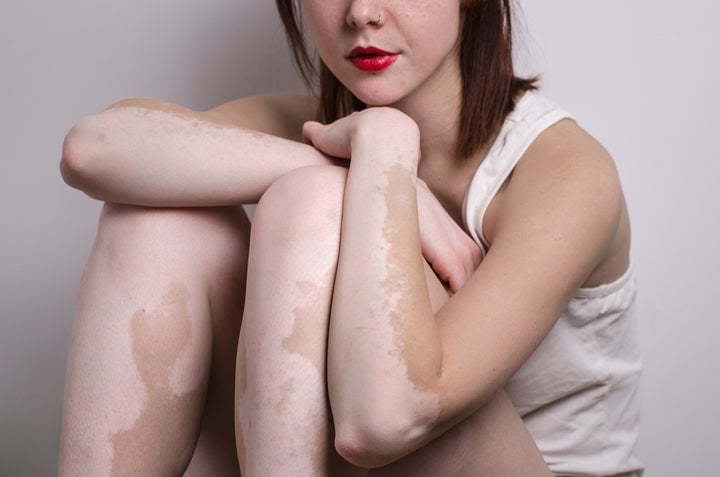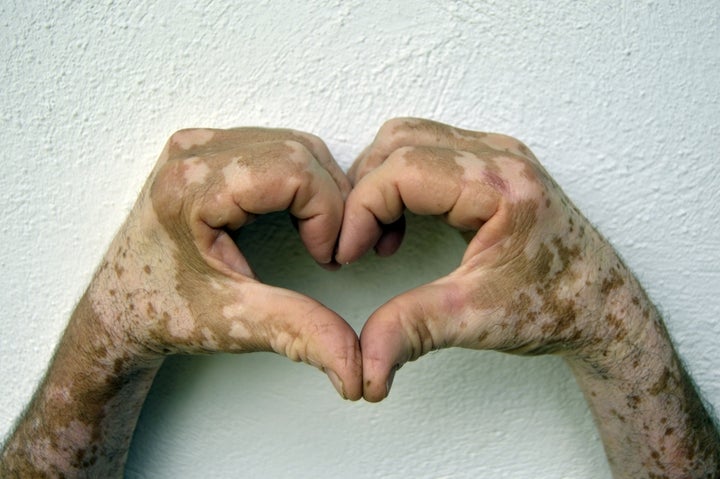
I was 30 years old when I started to disappear, each day a little more ― piece by piece. At first it didn’t bother me that much. Divorced with two small children, three tiny white spots were the least of my worries, but each day the spots grew bigger. Uneven white patches where pigment was disappearing overtook my chest, my neck, and my arms. The stark contrast between my healthy tanned skin and the white patches made it impossible to ignore. On the same schedule, my self-esteem and my pigment continued to fade. My family began to worry; my friends tried not to comment, strangers gawked and stared. My reflection became my enemy.
I made an appointment with a local dermatologist only to be told it was no big deal. What I had was called vitiligo, a skin disorder that affects only 1 to 2 percent of the world’s population. It was a freak occurrence, and I was the freak it was happening to.
It couldn’t be cured, but the doctor assured me there were no worries because it was neither contagious nor life threatening. And, “It doesn’t hurt,” the doctor said. But I knew differently. There is no physical pain associated with vitiligo, but the mental pain can be crushing. Vitiligo is a disfiguring disorder that affects not only the skin, but also the person’s self-esteem.
I tried to see my vitiligo as part of me like a hand or a foot, but that was impossible. This disorder was an intruder in my body, hijacking not only the color of my skin, but my dignity. It was beyond my control. This was something that could not be fixed.
My internal struggle was fierce. When someone I knew told me the vitiligo was a direct result of the sin in my life, referring to my divorce, the turmoil became worse. Could this be true? There was no medical explanation. Could there be a spiritual one?
What have I done, God? Are you mad at me? I promise I will be good, God! I promise I will fix it. Just tell me what to do. I begged and pleaded. I got no answers
When summer came, I donned my swimsuit and took my children to the pool. Unfortunately, no matter how much sunscreen I used, nothing could stop the contrast between my healthy skin and the vitiligo from becoming more pronounced. People asked me how I had gotten burned because the spots looked like scars. When a family member referred to me as “diseased,” I was devastated, but I managed to keep my feelings hidden. I was about to break, but I didn’t want anyone to know. I was getting desperate.
Since there was no cure, I searched for ways to help me cope. After scouring the internet, I decided to camouflage the spots with corrective make-up. The make-up was thick and didn’t match perfectly, but looking in the mirror and not having the white spots glaring back at me drastically changed my mood for the better.
Though time consuming, applying the make-up became a ritual for me, but I never stopped trying to find a cure. My searching finally led me to a treatment called PUVA, a process of taking medication and being exposed to strong UVB rays to stimulate the growth of pigment. The downside to the treatment was I had to stop wearing the make-up. Having to face the world without my shield was daunting, but I clung to the hope that my pigment would return.
One morning as I was getting ready for the day, my 8-year-old daughter walked into the bathroom.
“Mom, I‘m glad you’re not wearing that make-up anymore. That means you are feeling better about yourself,” she said as she picked up a make-up brush. Standing next to me in the mirror, she began to sweep it across her face emulating what she had seen me do. Stunned, it took me a second to ask her what she meant.
“You aren’t trying to cover up your spots, so that must mean you feel better about yourself. You are beautiful just the way you are,” she replied when I asked her to explain.
In that split second, I felt like a living, breathing oxymoron, both a failure and a success. A success for teaching my daughter such valuable lessons and a failure for not living them. Although the make-up I had been wearing wasn’t a perfect match, I was living under the assumption that it was the lesser of all evils and saved my children and me the embarrassment of having to tolerate ignorant comments about my skin disorder.
What I didn’t know was that my children didn’t care about the comments and questions. They cared about me. I was hiding behind the make-up to cover up my own lack of confidence, not their lack of confidence in me. They loved me completely as I was, for me… the real me. Not for the color of my hair or eyes or skin. To them I was Mom, not a reflection in the mirror. Many times I had told my children they were perfect just as they were, but it wasn’t until that day, I felt those words applied to me as well.
The treatment never worked. My pigment never returned, and my vitiligo has actually progressed through the years, but I have found new ways to cope. Sunless tanner helps to “erase” the spots on my skin, but there is nothing that can erase the lesson my daughter taught me that day. The people who love me love me just the way I am, spots and all, and not even vitiligo can take that away.

A Mississippi native, Mary Roberson Wiygul has taught in the public school system for over twenty years. She is currently a feature writer for Southern Sass Magazine, and her work has also been featured on Mamalode.com and humorwriters.org.